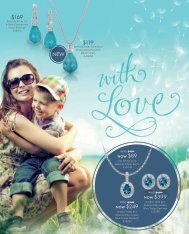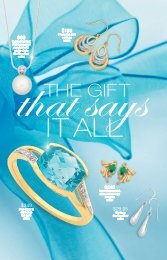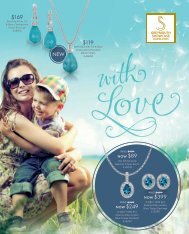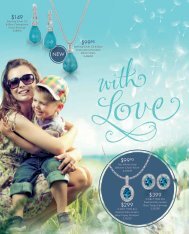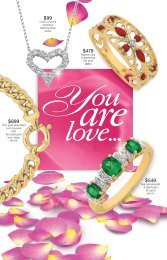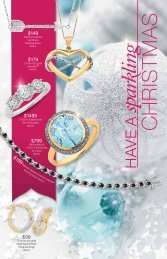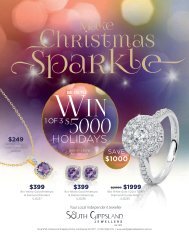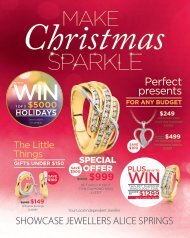Showcase Jewllers World of Pearl brochure
Showcase Jewllers World of Pearl brochure
Showcase Jewllers World of Pearl brochure
You also want an ePaper? Increase the reach of your titles
YUMPU automatically turns print PDFs into web optimized ePapers that Google loves.
SHOWCASE<br />
JEWELLERS<br />
YOUR SHOWCASE<br />
JEWELLERS GUIDE TO<br />
PEARLS
The <strong>Showcase</strong> Guide to<br />
the <strong>World</strong> <strong>of</strong> <strong>Pearl</strong>s<br />
The pearl is one <strong>of</strong> the ocean’s rarest treasures. Since ancient times natural<br />
pearls have been used as jewellery and ornaments and the oldest known<br />
pearl necklace is more than 4000 years old.<br />
<strong>Pearl</strong>s were <strong>of</strong>ten regarded as having a mystical quality and a life <strong>of</strong> their<br />
own because <strong>of</strong> their unique glow that seems to radiate from their very<br />
centre. In Roman times women would take pearls to bed in the belief that<br />
they would assist them to have pleasant dreams.<br />
So what exactly is a Natural <strong>Pearl</strong>?<br />
It is an accident <strong>of</strong> nature. A natural pearl is produced when a minute<br />
foreign object, perhaps a tiny living sea creature, becomes stuck inside<br />
the shell and tissue <strong>of</strong> an oyster. When the oyster cannot get rid <strong>of</strong> the<br />
‘irritant’ it eases the discomfort by coating it in ‘nacre’. Nacre is made up<br />
<strong>of</strong> microscopic crystals; each crystal perfectly aligned with the others so<br />
that it reflects light to produce a glow <strong>of</strong> light and colour.<br />
The pearl is built up <strong>of</strong> layer upon layer <strong>of</strong> nacre. The more layers, the more<br />
lustrous the pearl. However, because natural pearls are so rare, they are<br />
expensive which is why ‘Cultured <strong>Pearl</strong>s’ are a more affordable option.
Cultured <strong>Pearl</strong>s<br />
Giving nature a helping hand<br />
Most pearls sold today are cultured pearls. These are pearls that are made<br />
the same way as natural pearls in so far as an oyster coats an ‘irritant’<br />
with nacre. However the ‘irritant’ does not find its way inside the oyster<br />
by accident. This ‘irritant’ that is implanted is actually shell bead in salt<br />
water cultured pearls, or, in the case <strong>of</strong> freshwater cultured pearls, a small<br />
piece <strong>of</strong> tissue, which is implanted by a technician. These technologists<br />
then supervise the process so that the oyster produces the best pearl<br />
possible by ensuring it has the food it requires and that the water<br />
temperature remains constant and free <strong>of</strong> pollutants. Because there are a<br />
larger number <strong>of</strong> cultured pearls available than natural pearls, it is easier<br />
to match pearls that are much the same size and shape. So a necklace <strong>of</strong><br />
cultured pearls will be more even in shape and colour than one made up <strong>of</strong><br />
natural pearls.<br />
Imitation <strong>Pearl</strong>s are exactly that<br />
They are not real pearls. Both natural and cultured pearls are produced<br />
by an oyster, however imitation pearls are manmade. A round glass or<br />
plastic bead is simply coated in a pearly substance. The best way to tell if<br />
a pearl is imitation or not is to place it directly alongside a real one and<br />
compare the lustre. The real pearl will have a depth <strong>of</strong> lustre that the<br />
imitation cannot match. An imitation pearl generally will have a surface<br />
shine but no inner glow. Also look in the shaded area, in the real pearl you<br />
will see a clearly defined reflection, in the imitation pearl you won’t.
Your Guide to the Perfect <strong>Pearl</strong><br />
Whether a pearl is natural or cultured, there are five factors that need<br />
to be looked at to determine its quality.<br />
Lustre and Orient<br />
A pearl’s ability to reflect and refract light (lustre) creates an underlying<br />
play <strong>of</strong> colours within the pearl (orient) which gives a pearl its unique inner<br />
glow. The higher the lustre and orient the finer the pearl. The best way to<br />
judge the lustre and the orient is to see how bright the “reflections” are from<br />
the surface <strong>of</strong> the pearl (lustre), and to see how the strong the “rainbow<br />
colours” are surrounding the reflection (orient).<br />
Colour<br />
Colour is another important factor when determining value. There are two<br />
elements when considering colour: body colour and overtone. The ‘body<br />
colour’ refers to the basic colour; white, yellow or black. The ‘overtone’ refers<br />
to the slight tint that may be present. Very white pearls with a rose-coloured<br />
tint are the rarest and most expensive. The creamier the colour becomes the<br />
less costly they are. Cultured pearls are available in many colours including<br />
gray,black, pink, blue and gold.<br />
Freshwater Saltwater Akoya South Sea Tahitian<br />
Size<br />
As it is more difficult for oysters to grow large pearls, large pearls are more<br />
scarce and therefore more expensive. However two pearls <strong>of</strong> the same size<br />
may be valued differently because one may have a higher degree <strong>of</strong> lustre<br />
and orient than the other.<br />
Blemishes<br />
How clean a pearl is depends on how free it is from surface imperfections.<br />
Small blisters, spots and cracks can all diminish a pearl’s worth. The cleaner<br />
the surface, the better.<br />
Shape<br />
The more symmetrical the shape, the more valuable the pearl. Perfectly<br />
round pearls are extremely rare however nicely proportioned round, oval and<br />
tear shaped pearls are all highly valued. Irregularly shaped (baroque) pearls<br />
are less costly but their unusual shape can make for quite a dramatic look.
Types <strong>of</strong> <strong>Pearl</strong>s<br />
Akoya<br />
Grown in pearl saltwater oysters <strong>of</strong>f the coast <strong>of</strong> Japan and<br />
are one <strong>of</strong> the most familiar types <strong>of</strong> cultured pearls.<br />
They have a lovely orient and warm colour and rarely<br />
reach more than 9mm in size.<br />
Mabe<br />
Large half-round cultured pearls that grow against<br />
the inside shells <strong>of</strong> oysters rather than within the body.<br />
Because <strong>of</strong> their hemispherical shape are less expensive<br />
than regular round cultured pearls. They are usually<br />
mounted in earrings, rings and brooches.<br />
Freshwater<br />
These are pearls that are cultivated in mussels rather than oysters<br />
and are found in freshwater lakes and rivers. Generally they have<br />
an elongated shape and a milky translucent appearance.<br />
Keshi<br />
Small, irregular shaped seedless pearls that form naturally in many<br />
cultured pearl oysters.<br />
South Sea <strong>Pearl</strong>s<br />
Australian<br />
Rare and valuable large cultured pearls (10mm and larger) grown in<br />
the warm waters <strong>of</strong>f the Australian coast. Found in a variety <strong>of</strong> colours<br />
including white, silver, gold, and rose.<br />
Indonesian<br />
Large cultured pearls (8mm and larger) slightly smaller<br />
and creamier than their Australian counterparts.<br />
Tahitian<br />
Large gray to black cultured pearls<br />
(typically 8mm – 14mm)<br />
with overtones <strong>of</strong> reds,<br />
blues and greens.
How to care for your <strong>Pearl</strong>s<br />
Cultured pearls are precious gems and need to be treated as such.<br />
• When storing them in a purse or jewel box place them in a s<strong>of</strong>t gem<br />
bag or wrap them in a silk cloth to protect them from being scratched<br />
by harder stones, metal edges or other jewellery.<br />
• Don’t wear pearls in the shower, in the swimming pool<br />
or while playing sport.<br />
• Put your pearls on after you have applied your cosmetics,<br />
hairspray and perfume.<br />
• To help prevent discolouration wipe them frequently with a damp,<br />
clean cloth.<br />
• Never clean pearls with a harsh detergent or jewellery cleaner.<br />
A drop <strong>of</strong> mild detergent in warm water should be all you need.<br />
• Restring pearl necklaces at least once every two years to keep<br />
your jewellery looking its best and to keep your pearls secure.<br />
• For further information, visit your local <strong>Showcase</strong> Jeweller.<br />
www.showcasejewellers.com.au


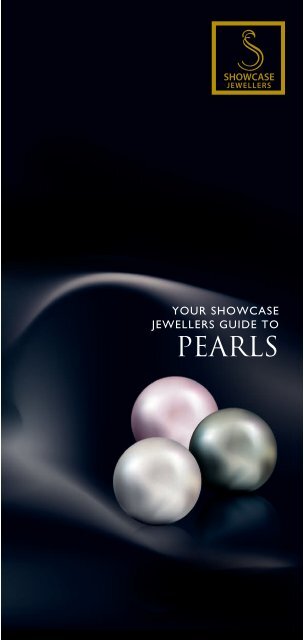


![JIM3930 KISS 2017 - Lookbook AUS - ALICE SPRINGS[8]](https://img.yumpu.com/59476582/1/190x234/jim3930-kiss-2017-lookbook-aus-alice-springs8.jpg?quality=85)

